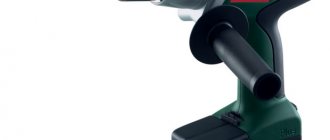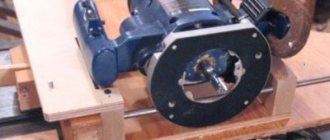A wood router is a cutting tool that can be used to cut, grind different types of wood, and also create complex, decorative patterns.
Depending on the model and design of the wood milling machine, industrial versions and manual samples are distinguished. The latter are intended for work in domestic conditions.
Why do you need a router?
A wood milling machine is a tool that allows you to make cuts, grooves, cut out joints, and also remove a thin layer of material. This tool is used in carpentry, when constructing furniture and when working with parquet or laminate. With its help, you can make longitudinal edges, complex patterns, tenon joints, and also cut grooves for dowels and dowels.
Why you need a router can be understood if you understand its varieties and structure, as this will help you choose the necessary tool.
Circular groove Source m-stone.ru
Caring for a hand-held milling device
The milling cutter is an unpretentious device that does not require complex maintenance. It will be enough if the technician takes care of cleaning the device from chips and dust, and also promptly replaces the brushes on the motor and checks the condition of the bearings on the motor shaft and cutters.
Hoses can be cleaned with a brush previously soaked in turpentine, which dissolves tree resin and removes dust deposits.
Milling is an interesting and exciting process that anyone can learn. The expert advice listed in the article will help beginners who do not know how to properly handle the tool. Having gained experience working with a woodworking machine, a young specialist will be able to create real masterpieces from wood (for example, Russian nesting dolls, boxes, etc.), mill tabletops, or independently cut out parts for furniture.
Types of router
To choose which hand router is suitable for a given purpose or intended for universal use, you should familiarize yourself with the manufacturing options of this tool and what each of them is used for.
Types of attachments Source perego-shop.ru
Rod
The submersible model has a body that is mounted on a special rod, along which it can move vertically. A support mechanism is attached to the bottom of the guide. The entire unit is placed on it and, using the side handles that need to be pressed, it is immersed in the material.
After finishing the work, release the handles and the router will rise up under the pressure of the springs. It can be used to make grooves, cutouts, holes or joints, as well as curly patterns. Due to its high functionality, this model is considered universal, but the increased weight does not allow it to work well in vertical areas. Working with a router for beginners with this tool will be simpler and more understandable.
Tool with immersion mechanism Source i.allo.ua
Edging
An edge tool (trimmer) is capable of working not only on horizontal surfaces, but also on vertical ones. Most often it is small in size, so it can be used with one hand. The body itself has a narrowing and a special rubberized coating. This is necessary to use it as a handle.
The bottom of the device has a sliding surface to prevent scratches and also for smoother movement. The immersion depth of the cutter is changed using a special scale. With this tool you can use additional attachments: a rip fence - for processing the edges of a part or corners, as well as a copying sleeve, which allows you to make cuts according to a template.
Using this tool, you can process laminated or veneered parts, select grooves, round corners, fit blanks, and make shallow cutouts for decoration. The trimmer is recommended for use in workshops that require daily edging work.
Edging router Source www.rucne-naradie.sk
Lamellar
The body of such a tool has a horizontal body and is similar in design to a grinder. At the bottom it has a mechanism for operation, and a wide handle is attached above it. This model is equipped with a disk cutter for cutting into wood. To work, you need to press the tool on the material to immerse the cutter inside. Thus, you can make a special groove for attaching oval parts (lamellas).
It is recommended to work with a manual router of this type for making grooves or trimming parts. This machine is not suitable for rare use, since its purchase will not pay for itself. Therefore, you should choose such a model for frequent use in workshops for which it is needed every day.
Lamellar router Source laukar.com
Additive
This type of milling tool is similar in shape and design to a lamellar one, but there is a significant difference in its mechanism. To operate, this model uses 2 spiral cutters that work on the principle of a drill. With their help, an accurate connection of parts is made, since they cut into the material at a certain distance from each other. When immersed, the tips cut grooves into which dowels can be installed.
This type of tool is used in furniture production to connect parts whose fastening areas need to be made invisible. The cutter for this tool can be dowel or dowel. With their help, you can make holes for detachable and non-demountable connections.
Filler milling machine Source harrer.at
Rotary
This type of tool is similar in operating principle to a rod tool, but has a smaller size and a narrowed body, like an edging tool. It can be used for woodworking or ceramic tile work. It is also capable of processing plasterboard floors, chipboard, plastic and soft types of metal. Its speed reaches 30 thousand per minute, which makes it possible to work with hard materials.
The small size of the device makes it possible to work with a manual wood router using one hand, since its weight is small. When replacing a cutter, you can install a diamond rod or a cutter for working with ceramics. Using this type of tool, if it is equipped with speed control, work is performed on materials of varying densities, for example, cutting holes or processing edges.
Rotary router Source allegroimg.com
Edge processing using templates
To perform wood edge processing, experts recommend using templates. Below you can familiarize yourself with the processing features of the outer parts of the product.
If the width of the part is no more than the length of the cutting edge
The sample is securely mounted to the table. The cutter is installed in such a way that the roller can move along the template, and the cutter can move along the surface being processed. Next you will need to decide on the speed of movement. After the tool is turned on, you need to carefully move it along the workpiece. You can not only pull the woodworking machine, but also gently push it.
The width is greater than the length of the cutting part
After the first pass, the workpiece must be removed and a second pass must be performed. The processed part can perform the functions of a workpiece. The bearing must be guided along the machined surface. In cases where the cutting part is again missing, an additional pass should be made.
At the final stage, the product being processed is turned face down. The part is fixed with clamps. The craftsman will need a cutter with a bearing at the end, which will move along the treated surface. In this way, thick parts can be processed.
Obtaining a figured and curved edge
In order for the curly edge to turn out beautiful, it is important to process the workpiece well. There should be no cracks, bevels, or uneven edges. This will avoid the appearance of flaws during milling.
Important! If it is necessary to create a curved workpiece, it is recommended to carry out rough processing, bringing the product profile closer to the desired sample.
Next comes the finishing of the edge parts, during which you need to use templates and be as careful as possible.
Climb milling is rarely used, only when there is a possibility of obtaining a flake
Main characteristics
Working with a milling cutter largely depends on the characteristics of the tool. The weight of the device is directly related to its power, since the more power there is, the heavier and larger the motor inside the case. The maximum size and length of the cutter also depends on the engine power. It also gives rise to the classification of tools by size:
- a device weighing 2-3 kg and a motor of 420 - 750 W is considered light;
- a medium-sized milling cutter has a power from 800 to 1450 W and a weight of up to 5 kg;
- a tool is considered heavy if it has a 1500-2300 W motor installed and its weight starts from 6 kg.
Professionals give advice for dummies on how to choose a manual wood router for the home, after analyzing the volume and complexity of the work. Beginners should opt for a lightweight instrument, as it is easier to learn.
Small device Source cdnmedia.220-volt.ru
Its heating speed also depends on the power of the device: the weaker the engine, the faster it heats up. Therefore, to make deep cuts or frequent milling, you should use a tool that has a motor of 1500 W or more installed.
If there is a choice of models whose power differs by no more than 200 W, then you should choose the one with the maximum power, since it will be able to work under the same loads and not overheat.
One of the important parameters for working with a milling cutter on wood or hard material is the number of revolutions it makes in 1 minute. (rpm). Most often, the device has a function for changing the speed, since in its absence it will become less universal and will not be suitable for all materials.
To operate, the milling cutter can use speeds from 3 to 35 thousand rpm. Also, the number of rotations depends on the diameter of the cutter. When working with thick cutters, you should reduce the speed to prevent the material from burning. It is necessary to work with hard rocks at low speeds, since the high density of the material may cause the tool to break.
Option for working with tiles Source domagazine.ru
The working stroke of a cutter is the depth to which the cutter can be immersed. For small models, the maximum value of this parameter reaches from 30 to 50 mm, and for large ones – 80 mm. The higher this value, the larger and heavier the device will be.
It is impossible to cut a deep groove on the first pass, so tools of different sizes are required. First, a 3 mm groove is made with a light tool. Next, the groove is deepened using a medium-sized bottom milling cutter to a depth of up to 6 mm, after which a heavy unit is used to increase the groove to 8 mm or more.
It is impossible to make a groove whose depth is greater than the working stroke, but it is possible to make a groove less. To do this, you need to change the inclination of the vertical stop using a special regulator, which is installed in the upper part of the tool. With it you can adjust the depth with an accuracy of 0.1 mm.
Adjusting the working stroke works the same for all types of cutters. Using a special stop, the immersion stops the moment the cutter reaches the desired depth.
Classification
Types of equipment:
- Horizontal and vertical milling. They are equipped with special working surfaces, the angle of which can be changed.
- Non-console vertical.
- Longitudinal. The design of such machines has two racks.
- Drum and carousel.
- Copying.
- Keyed.
- For processing end surfaces.
- Specialized.
Machines for single tasks and multifunctional machines are sold. The second type includes drilling and milling machines. Used for drilling workpieces and changing their shapes.
Equipment and additional features
Using variable equipment, you can simplify and speed up wood milling work:
- A rip fence is a device that helps you rout areas that run in the same direction as the edge of a part. It is attached to the working edge of the tool using 2 rods and secured with screws. The accuracy with which you can adjust the position of the cutter and how high-quality the cut will be depends on how tightly this part is tightened. Depending on the model and manufacturer, the number of screws varies from 2 to 4.
- A cutter may have several cutting edges. An increase in the number of cutting surfaces affects the accuracy of the groove made, and a decrease affects the speed of its cutting. Most often, the kit comes with a cutter for 2 cutting edges, but these surfaces can be from 1 to 4. It is recommended to use a tool with 1 knife for rough work, and finish it with a cutter with 4 surfaces.
Types of incisors Source p0.zoon.ru
- The cleanliness of the processing and the cutting speed depend on the level of inclination of the knives on the cutter. There are straight and oblique cutting surfaces. The second option makes the holes more accurately and can be either left or right inclined. One produces more accurate chip removal, and the second produces high-quality cuts.
- The milling cutter sole is the part that will be in contact with the material. It must have increased strength to support the cutter's own weight and operator pressure. Most often they are made of cast or stamped metal, less often of plastic, since it is very fragile. The cast part is installed on expensive models, and the stamped part on cheaper ones. A smooth plastic cover is installed on top of it, which should prevent scratches and make the movement of the tool easier and smoother. If the nozzle breaks, it can be replaced with a similar one, or one made independently from scrap materials, for example, plywood.
- The miter gauge and compass can be used for rounding parts, finishing corners and cutting round parts of different sizes.
Compass for cutter Source 7routertables.com
- The guide bar is similar in properties and operating principle to the side stop, but it can be fixed independently of the edge of the workpiece. The length of removal from the material is adjusted using a special ruler, which is secured with clamps. An attachment is installed on the router itself, which moves along the cells in the ruler.
- The copy sleeve and ring are used together. The first part is needed for complex figured cutting according to a drawn template. During operation, the edge of the device rests against the border of the design, which is why the copy will come out slightly larger than the original template. The ring is needed to close the groove for the bushing if it is not needed.
- The guide rod is a mechanism for smoothly immersing the cutter into the material. It is installed on vertical type devices. With the help of springs installed inside it, the unit is lifted automatically and smoothly. Manufacturers often equip rods with a protective casing that prevents dust from entering the structure.
Let’s just look at the option with an oval background (outline)
Handmade carved wooden furniture
To perform this type of carving, grooves are cut along the outline of the sketch, which are then ovalized (rounded) both from the background and from the ornament side.
First, make cuts with a blunt knife along the contour. On curves, cuts are made using semicircular chisels of suitable width.
The background of the picture is also removed with a knife or a straight chisel, maintaining a 30-degree inclination of the cut to the plane of the workpiece.
On the side of the image of the ornament, the contour should be steeper, on the background side it should be sloping, this will allow the pattern to look more convex. After finishing the rounding, you can use cutters to sand the product with fine sandpaper.
With a selected background.
The difference between a carving with a selected background and a flat-relief carving with an oval background is that the background around the ornament is removed with one inclination angle to the workpiece plane selected for the entire product (30-45°) and is not further processed (rounded) with a cutting tool and not sanding.
With pillow background.
Cushion carving is a type of carving with an oval outline. The only difference is that the background does not remain flat and may be lower than the plane of the product’s ornament. Raising the ornament above the background has its advantages, but also its disadvantages. Cutting the entire background to the same height takes quite a lot of time, especially with large volumes. In addition, this work requires skill and accuracy so as not to damage the product.
With a selected and trimmed background.
This type differs from others in that depressions are created around the main picture, which is why the image seems to rise above the background to a different height (usually within 5-7mm), turning out to be deeper and more interesting in appearance.
It is very difficult to see and feel the difference between different types of carving. Often many types are combined in one product, because of this it is not worth giving clear definitions and starting any disputes on this basis.
Video description
This video shows useful additional devices:
- Adjustment of the cutting depth should be installed on all models of the tool, since it is possible to use a wood router with high precision only with the help of this part. The regulator should have a scale with marks, and the more accurately you can adjust the depth, the better the cut will be. Most often these divisions are made in millimeters, but they can also be in inches. The most precise products can change the depth of immersion by 0.1 mm. For more convenient changes, it can be equipped with a special screw. This part is usually made in the form of a rod, with which the router rests on the part when the desired depth is reached.
Device with regulator Source i.pinimg.com
How to install
Benchtop milling machines are unpacked, assembled and placed on a level surface. Connect to the network and the hood - vacuum cleaner. The base can easily withstand the light weight of workpieces and processing loads. Horizontally and vertically milling machines are installed on the concrete floor. The pouring thickness must be more than 300 mm.
Additionally, they are secured with bolts or studs so that they do not move due to vibration. If the floor does not match, dig a hole 500 mm deep. Sand is poured onto the bottom. Gravel on top. The thickness of the pillow is 200 mm. Then the cement mortar is poured and leveled.
Important!
For stable operation, equipment weighing more than a ton is recommended to be placed on hydraulic supports.
Video description
This video shows the main characteristics when choosing a router:
- A system that allows the cutter to start moving smoothly rather than jerkily can help avoid overloading the device when starting work. It also helps to process parts more accurately and prolongs the life of the cutter.
- An electronic device for automatically adjusting speed during operation is capable of maintaining the desired speed if a harder section of material, for example a knot, appears in the path of the cutter. This mechanism stabilizes the operation of the cutter and improves the quality of processing.
- The temperature control module is a very important design element when choosing a router, as it is responsible for the safety of the device. When the mechanism overheats, it automatically turns off the current supply to the motor. Instead, to reduce the cost of the design, a color indicator can be installed, which will show how overheated the unit is.
- Before choosing a router for working in a confined space, you should check whether it has LED lighting for the area in which the work will take place. This is necessary to use the device in places with limited lighting.
Tool with LED backlight Source prosto-instrumenty.ru
- The power cord is a very important element of the router. Its length should be long enough to make it convenient to work at a distance from the outlet. It is necessary that it does not interfere with work and visibility. A wire braided with reinforced thread will be stronger and more durable.
- A mount for installing a nozzle, which makes it possible to connect a construction vacuum cleaner, will help clean the work surface from dust and debris during work. This will protect the device from unnecessary damage, as well as improve visibility and simplify operation.
There are various attachments for installation on the device, since using a router on wood or other material requires the help of special cutters, because each of them can make a cut of a different shape:
- A straight groove cutter is made in the form of a cylinder and is needed for rectangular grooves.
- The U-shaped bit is used for a rounded groove, which is made using a hand-held device.
- A V-shaped cutter can make a groove at different angles of inclination of its walls. To do this, several such nozzles of different sizes are used.
V-shaped cutter Source cdn.vseinstrumenti.ru
Types of cutters used
Each type of material being processed requires the use of an appropriate attachment. Externally, the cutter consists of two parts: the cutting edge (working part) and the shank. It is important to know that pliable soft woods are processed with attachments made from lightweight materials, while hard wood species require an appropriate hard cutter.
There is another classification of nozzles:
- profile - simple processing of wood products;
- cone-shaped - processing at an angle;
- rectangular - working with grooves;
- V-shaped to produce holes with a 45-degree slope;
- disk - you can create different grooves in width and depth;
- molding will help to round the edge;
- rebated for quarter milling;
- “swallow’s nest” – tenon joints;
- fillets to create details of the same name on the edges.
It is worth knowing: for a manual household router you should use bearingless attachments - this will help in processing tools in any convenient place.
Choosing a wood router
Below is information on which manual wood router to choose for home use and their rating, which will help you get acquainted with the models:
- Bosch GMF 1600 CE
It has a high cost and comparable quality. This model has a 1.6 kW motor and a drive that can immerse the cutter by 75 mm. The speed controller allows you to change their number from 10 to 25 thousand rpm. The immersion fixation scale allows adjustment with an accuracy of 0.1 mm.
This device weighs 4.3 kg and has LED backlighting. You can connect a vacuum cleaner to it, and it also has a turret and is able to maintain a constant speed under load.
- Makita RP1800F
Weighs 6 kg and can immerse the cutter 70 mm. The engine power is 1.85 kW. The speed can be adjusted from 10 to 22 thousand rpm, and the power cable length is 4 m.
The disadvantage of the device is the presence of only one collet, which is supplied in the kit. This one can regulate constant speed and lock the spindle under load, and it also has a turret.
Model Makita RP1800F Source 24ima.ru
- Hitachi M12V2
It has a 2 kW motor with the ability to deepen the cutter by 65 mm. The set includes 12 and 8 mm collets.
The disadvantage of the device is the rough change in immersion depth. The length of its power cable is 3.8 m. This milling cutter has a function for maintaining a constant speed under load, a speed control from 8 to 20 thousand rpm, as well as a turret stop and spindle locking under pressure.
When choosing a router, you should pay attention to whether such a model has adjustment of speed and precise immersion depth. These parameters improve the versatility of the device and make it possible to make more regular grooves.
Model Hitachi M12V2 Source www.skypka1.com
Briefly about the main thing
A milling cutter is a device for processing parts and making grooves in them. It can be used to make chamfers, locking joints and figured carvings.
The most universal device is considered to be a plunge router, while the most professional and highly specialized devices are the lamellar and filler milling machines. Rotary and edging routers are needed for working in confined spaces or for special jobs.
The choice of a router directly depends on its functionality and what additional functions it has.
Ratings 0
Is it possible to make money on CNC?
CNC machine
, then you can open your own small business producing furniture, interior items, toys, souvenirs and other products.
Interesting materials:
Which palm trees grow fast? What peonies can be grown in a pot? What fruit trees grow well in sandy soil? What fruit trees can be grown from seeds? What plants grow well in acidic soils? What plants love shade and grow under trees in the forest? What plants grow in alkaline soils? What plants grow only in Crimea? What plants grow in May? What plants grow in Moscow parks themselves?











